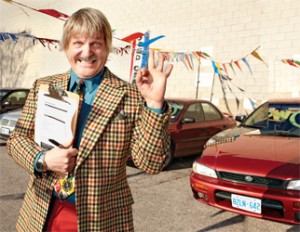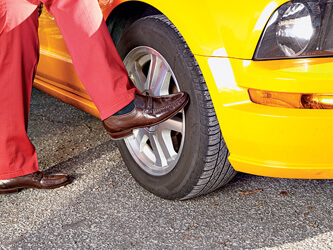Car buying: Driving a hard bargain
Buying a vehicle means going head-to-head with a wily salesperson. You can get the upper hand by understanding these common tactics.
Advertisement
Buying a vehicle means going head-to-head with a wily salesperson. You can get the upper hand by understanding these common tactics.
 Most people can vividly recall the thrill of buying their first car, not to mention the nausea, sweaty palms and butterflies. My experience was no different. Armed with an ad promising an unbeatable deal on a brand new Chevy Cavalier, I bummed a ride to the dealership and announced my intention to snatch one at the advertised price.
The salesperson— a plump, elderly gentleman in a somewhat garish sport jacket—began a big show of consulting with his manager and checking the books to see if the sale-priced cars were still available. After a few minutes, he triumphantly announced there was one left at the back of the lot.
We hopped into his massive Oldsmobile and drove around the side of the building. I sprinted over to the car of my dreams and stared in disbelief at the interior. The seats, flooring and centre console were all missing. Only bare sheet metal and some wiring stared back at me.
When I calmly pointed this out, the salesman looked me straight in the eye and assured me the vehicle was merely undergoing a pre-delivery inspection. After I questioned the truth of that statement, his demeanour suddenly changed and he barked, “Well, do you want it or not? The sale ends today.” Needless to say, I passed on the Cavalier and vowed never to return to that dealership.
Most car dealers do not subscribe to the P.T. Barnum philosophy of salesmanship, but there are enough bad apples out there to warrant a careful approach to such a large purchase. That’s why we’ve assembled a list of the most common misleading or outright illegal sales tactics, with expert advice on how to steer clear of the scams.
Most people can vividly recall the thrill of buying their first car, not to mention the nausea, sweaty palms and butterflies. My experience was no different. Armed with an ad promising an unbeatable deal on a brand new Chevy Cavalier, I bummed a ride to the dealership and announced my intention to snatch one at the advertised price.
The salesperson— a plump, elderly gentleman in a somewhat garish sport jacket—began a big show of consulting with his manager and checking the books to see if the sale-priced cars were still available. After a few minutes, he triumphantly announced there was one left at the back of the lot.
We hopped into his massive Oldsmobile and drove around the side of the building. I sprinted over to the car of my dreams and stared in disbelief at the interior. The seats, flooring and centre console were all missing. Only bare sheet metal and some wiring stared back at me.
When I calmly pointed this out, the salesman looked me straight in the eye and assured me the vehicle was merely undergoing a pre-delivery inspection. After I questioned the truth of that statement, his demeanour suddenly changed and he barked, “Well, do you want it or not? The sale ends today.” Needless to say, I passed on the Cavalier and vowed never to return to that dealership.
Most car dealers do not subscribe to the P.T. Barnum philosophy of salesmanship, but there are enough bad apples out there to warrant a careful approach to such a large purchase. That’s why we’ve assembled a list of the most common misleading or outright illegal sales tactics, with expert advice on how to steer clear of the scams.
 Clearly, the dealer’s real goal is simply to get you through the door. According to George Iny of the Automobile Protection Association (APA), even after a bait-and-switch has been revealed many of us are still powerless to resist the upselling tactics. “Thirty per cent of the time you’ll leave with a new car anyway,” he estimates.
If you suspect a bait and switch, call the dealer before you venture down and verify the price and availability of the advertised vehicle. Iny also suggests taking the misleading ad to a competitor who can more easily decipher it and tell you what the catch is. Of course, they’ll be trying to sell you a car too, but will be motivated to look like the good guy and offer a better deal. “It’s a bit like in martial arts where you use the force of your opponent against them,” he explains.
Clearly, the dealer’s real goal is simply to get you through the door. According to George Iny of the Automobile Protection Association (APA), even after a bait-and-switch has been revealed many of us are still powerless to resist the upselling tactics. “Thirty per cent of the time you’ll leave with a new car anyway,” he estimates.
If you suspect a bait and switch, call the dealer before you venture down and verify the price and availability of the advertised vehicle. Iny also suggests taking the misleading ad to a competitor who can more easily decipher it and tell you what the catch is. Of course, they’ll be trying to sell you a car too, but will be motivated to look like the good guy and offer a better deal. “It’s a bit like in martial arts where you use the force of your opponent against them,” he explains.

Share this article Share on Facebook Share on Twitter Share on Linkedin Share on Reddit Share on Email